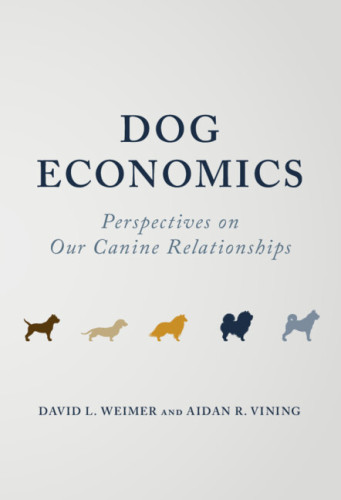New UW–Madison book introduces “dogonomics”
While much has been written about the connection between dogs and humans, a new book coauthored by David L. Weimer of the La Follette School of Public Affairs at the University of Madison–Wisconsin is among the first to use an economic lens to consider the uniqueness of this interspecies relationship.
Although we have come to primarily view our dogs as family, Dog Economics: Perspectives on Our Canine Relationships examines their role as both family and property. The book, released last month and coauthored by Weimer and Aidan R. Vining of Simon Fraser University, takes a novel approach by applying foundational economic concepts to our relationship with dogs.

David Weimer
Weimer and Vining call this approach “dogonomics.” Through this lens, they interrogate a host of phenomena related to the unique human-dog relationship. For example, the spike in puppies adopted during the COVID pandemic can be understood both in terms of the increased value of companionship and lower opportunity costs of caring for dogs when people were isolated in their homes. In economics, opportunity costs refer to the alternatives that a consumer gives up when they make a purchasing decision.
Family economics, which applies traditional economic concepts such as production or division of labor to the family, helps explain how dogs can be used as complements to, or even substitutes for, children. Increasing demand for dog breeds featured in popular culture can be explained by the economic theory of fads, which is used to study how trends go in and out of style.
“My interest here grew out of my effort to help economists value reductions in canine mortality resulting from regulations, such as those intended to improve the quality of pet food,” Weimer said. “I was fortunate to work with a team of former students to develop an estimate of the value of statistical dog life.”
Typically, value of statistical life is a concept used in cost-benefit analysis to determine how much a person would be willing to pay with goods or services to reduce risks of mortality by a very small amount.
Dog Economics also traces the historical development of the close human-canine association, which goes back more than twenty thousand years to when humans began domesticating dogs for use in hunting, standing guard, and providing warmth and companionship. The companionship piece grew when dogs moved with humans to cities. Yet, even the most personal aspects of this deep relationship developed over millennia can be better understood from an economic perspective.
 Strictly modern phenomena can also be viewed through the lens of dogonomics. Difficult end-of-life decisions like euthanasia and heroic medical care invite a principal-agent framework to explore the implications of such challenging ethical considerations. The principal-agent framework helps when there is a conflict between the priorities of principal actors and the agents authorized to work on their behalf. In this case, it helps explore the tensions between wanting to care for your dog in the best way while also avoiding resorting to measures that cause unnecessary financial burden. Meanwhile, the rapidly expanding pet insurance market could result in moral hazard that leads to excessive and risky heroic care.
Strictly modern phenomena can also be viewed through the lens of dogonomics. Difficult end-of-life decisions like euthanasia and heroic medical care invite a principal-agent framework to explore the implications of such challenging ethical considerations. The principal-agent framework helps when there is a conflict between the priorities of principal actors and the agents authorized to work on their behalf. In this case, it helps explore the tensions between wanting to care for your dog in the best way while also avoiding resorting to measures that cause unnecessary financial burden. Meanwhile, the rapidly expanding pet insurance market could result in moral hazard that leads to excessive and risky heroic care.
“Aidan Vining and I very much enjoyed writing this introduction to dogonomics,” Weimer said. “We hope it will stimulate economists to join the many other disciplines that contribute to understanding interspecies relationships. Catonomics anyone?”


